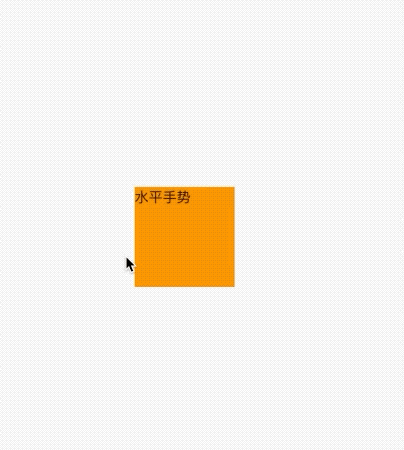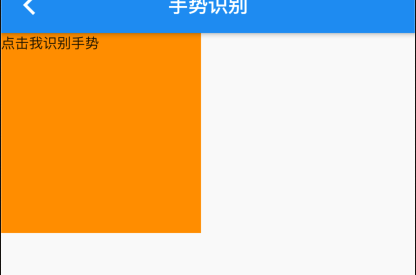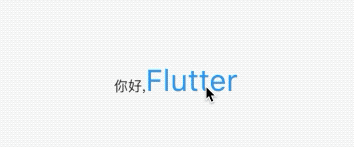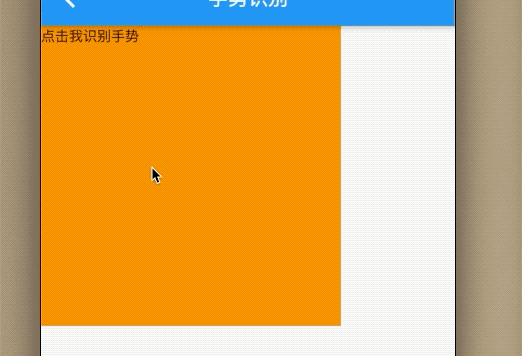8.2 手势识别
首先介绍处理手势的组件GestureDetector和GestureRecognizer,后续在讲解其他复杂情况
8.2.1 GestureDetector
首先看下属性:
GestureDetector({
Key key,
this.child,
this.onTapDown,// 手势按下
this.onTapUp,//抬起
this.onTap,//点击
this.onTapCancel,//点击取消 移动出范围触发
this.onSecondaryTapDown,//第二个指头点击
this.onSecondaryTapUp,
this.onSecondaryTapCancel,
this.onDoubleTap,//双击
this.onLongPress,//长按
this.onLongPressStart,//长按开始
this.onLongPressMoveUpdate,//长按移动
this.onLongPressUp,//长按抬起
this.onLongPressEnd,//长按结束
this.onVerticalDragDown,//垂直拖拽 按压
this.onVerticalDragStart,
this.onVerticalDragUpdate,
this.onVerticalDragEnd,
this.onVerticalDragCancel,
this.onHorizontalDragDown,//水平拖拽 按压
this.onHorizontalDragStart,
this.onHorizontalDragUpdate,
this.onHorizontalDragEnd,
this.onHorizontalDragCancel,
this.onForcePressStart,
this.onForcePressPeak,
this.onForcePressUpdate,
this.onForcePressEnd,
this.onPanDown,
this.onPanStart,
this.onPanUpdate,
this.onPanEnd,
this.onPanCancel,
this.onScaleStart,//放大开始
this.onScaleUpdate,
this.onScaleEnd,
this.behavior,
this.excludeFromSemantics = false,
this.dragStartBehavior = DragStartBehavior.start,
})
点击 双击 长按
点击、双击、长按可以并存,相互无影响。我们设置触控区域为100X100,方便操作。
例子:
GestureDetector(
child: Container(
width: 100,
height: 100,
child: Text(_string == null ? '点击我识别手势' : _string),
color: Colors.orange,
),
onTap: () {
setState(() {
_string = '手势按压';
});
},
onDoubleTap: () {
setState(() {
_string = '手势双击';
});
},
onLongPress: () {
setState(() {
_string = '手势长按';
});
},
}
同时监听
onTap和onDoubleTap事件时,用户触发tap事件会有200毫秒延迟,因为用户有可能触发双击事件,所以组件会等待一段时间来确定是否是双击,如果只监听onTap,则无延迟。
效果:

拖动 滑动
长按手势根据移动的LongPressMoveUpdateDetails可以更新UI,根据LongPressStartDetails计算得出手指在组件上的位置计算得出应该移动的距离。
Stack(
children: <Widget>[
GestureDetector(
child: Container(
width: 100,
height: 100,
margin: EdgeInsets.only(
left: _left > 0 ? _left : 0, top: _top < 0 ? 0 : _top),
child: Text(_string == null ? '点击我识别手势' : _string),
color: Colors.orange,
),
onLongPress: () {
setState(() {
_string = '手势长按';
});
},
onLongPressMoveUpdate: (LongPressMoveUpdateDetails d) {
setState(() {
_left = d.localPosition.dx - _offset.dx;
_top = d.localPosition.dy - _offset.dy;
});
},
onLongPressStart: (LongPressStartDetails d) {
_offset =
Offset(d.localPosition.dx - _left, d.localPosition.dy - _top);
},
)
],
)
| 回调 | 含义 |
|---|---|
| onLongPressStart | 长按开始的位置 |
| onLongPressMoveUpdate | 手指移动回调 |
LongPressStartDetails.localPosition是基于屏幕的位置的offset
效果:

当然也可以在水平或者垂直方向拖动,或者同时都监听。
Stack(
children: <Widget>[
GestureDetector(
child: Container(
width: 100,
height: 100,
margin: EdgeInsets.only(
left: _left > 0 ? _left : 0, top: _top < 0 ? 0 : _top),
child: Text(_string == null ? '点击我识别手势' : _string),
color: Colors.orange,
),
onHorizontalDragUpdate: (DragUpdateDetails detail) {
setState(() {
_string = '水平手势';
_left += detail.delta.dx;
_top += detail.delta.dy;
});
},
onVerticalDragUpdate: (DragUpdateDetails detail) {
setState(() {
_string = '垂直手势';
_left += detail.delta.dx;
_top += detail.delta.dy;
});
},
),
],
)
垂直和水平手势冲突,同时只能响应一个,谁先响应后续都是谁监听。
效果:

缩放
双指在屏幕上张开和收缩就是放大和缩小手势,本例子放大和缩小widget。
Stack(
children: <Widget>[
GestureDetector(
child: Container(
width: _width,
height: _height,
margin: EdgeInsets.only(
left: _left > 0 ? _left : 0, top: _top < 0 ? 0 : _top),
child: Text(_string == null ? '点击我识别手势' : _string),
color: Colors.orange,
),
onScaleUpdate: (ScaleUpdateDetails detail) {
setState(() {
_width = 200 * detail.scale.clamp(0.5, 2);
_height = _width;
});
},
),
],
)
效果:

8.2.2 GestureRecognizer
GestureRecognizer是抽象类,flutter提供了已经实现了的类,比如TapGestureRecognizer、DoubleTapGestureRecognizer、DragGestureRecognizer等供开发者可以实现基本的操作。
bool _selected = false;
Widget _body2() {
return Center(
child: Text.rich(
TextSpan(text: '你好,', children: [
TextSpan(
text: 'Flutter',
recognizer: _gestureRecognizer(),
style: TextStyle(
color: _selected ? Colors.blue : Colors.orange,
fontSize: _selected ? 30 : 20))
]),
),
);
}
GestureRecognizer _gestureRecognizer() {
return TapGestureRecognizer()
..onTap = () {
setState(() {
_selected = !_selected;
});
};
}
效果:

8.2.3 手势竞争
竞争
在前边的例子中有一个垂直和竖直方向的监听,假如我们斜着拖动时哪个方向会生效?实际上取决于第一次移动时两个轴上的位移分量,哪个轴在本次竞争中胜出。实际Flutter的手势识别竞争引入了一个Arena的概念,Arena是竞技场的意思,在每一个手势识别器都是 一个竞技场,在发生滑动事件时,他们都要去竞技场去竞争本次的处理权,而最终只有一个竞争者会胜出。
例子:
我们以拖动手势为例,同时识别垂直和水平手势,当 用户按下屏幕就会触发(垂直和竖直方向),一旦某一个方向胜出,直到手势结束都会沿着该方向移动。
Stack(
children: <Widget>[
GestureDetector(
child: Container(
width: 100,
height: 100,
margin: EdgeInsets.only(
left: _left > 0 ? _left : 0, top: _top < 0 ? 0 : _top),
child: Text(_string == null ? '点击我识别手势' : _string),
color: Colors.orange,
),
onHorizontalDragUpdate: (DragUpdateDetails detail) {
setState(() {
_string = '水平手势';
_left += detail.delta.dx;
_top += detail.delta.dy;
});
},
onVerticalDragUpdate: (DragUpdateDetails detail) {
setState(() {
_string = '垂直手势';
_left += detail.delta.dx;
_top += detail.delta.dy;
});
},
),
],
)
垂直和水平手势冲突,同时只能响应一个,谁先响应后续都是谁监听。
效果:

手势冲突
由于手势竞争最终只有一个获胜者,所以,当多个手势识别器时,可能会产生冲突,假如有可以上下移动手势,我们也想监测在他上面按下和抬起手势。
String _moveDetail = '';
Widget _body3() {
return Stack(
children: <Widget>[
GestureDetector(
child: Container(
width: _width,
height: _height,
margin: EdgeInsets.only(
left: _left > 0 ? _left : 0, top: _top < 0 ? 0 : _top),
child: Text((_string == null ? '点击我识别手势' : _string) + _moveDetail),
color: Colors.orange,
),
onTap: () {
setState(() {
_string += '点击手势';
});
},
onTapUp: (TapUpDetails detail) {
setState(() {
_string += 'up:' + detail.toString();
});
},
onHorizontalDragUpdate: (DragUpdateDetails detail) {
setState(() {
_moveDetail = detail.toString();
});
},
),
],
);
}
可以发现当手势结束的时候,up也没有回调。当点击时是tap胜出,当手指开始移动的时候,tap和onHorizontalDragUpdate开始竞争,然后onHorizontalDragUpdate胜出,后续的操作都是有onHorizontalDragUpdate来处理,所以最终up并未回调。

假如我们也想监听up手势,那么该怎么处理?可以监听onHorizontalDragend或者使用原始指针Listener来处理。
Positioned(
top:80.0,
left: _leftB,
child: Listener(
onPointerDown: (details) {
print("down");
},
onPointerUp: (details) {
//会触发
print("up");
},
child: GestureDetector(
child: CircleAvatar(child: Text("B")),
onHorizontalDragUpdate: (DragUpdateDetails details) {
setState(() {
_leftB += details.delta.dx;
});
},
onHorizontalDragEnd: (details) {
print("onHorizontalDragEnd");
},
),
),
)
感兴趣的同学可以自己实验下哦。。。